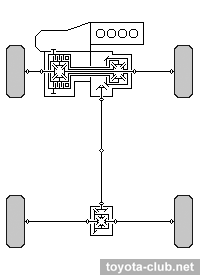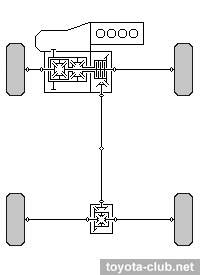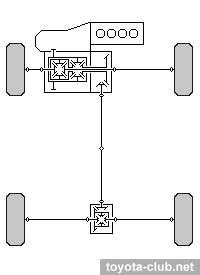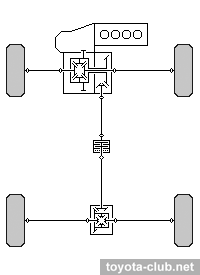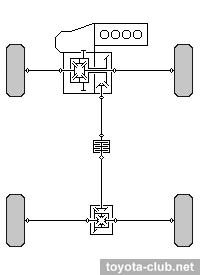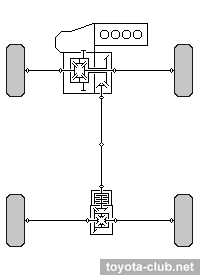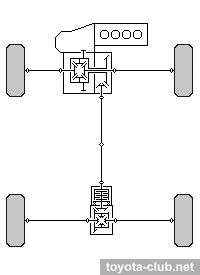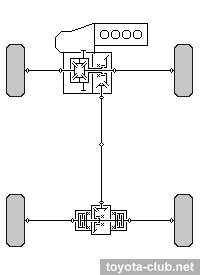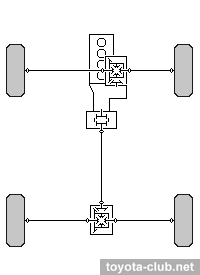|
Eugenio,77
mail@toyota-club.net
© Toyota-Club.Net
Feb 2004 - Jun 2023
Part 1. Initially FF models with automatic transmissions
Part 2. Initially FR models with automatic transmissions
Part 3. Initially FF models with manual transmissions
1.1. Full-time all wheel drive
|
1.1.1. STD I type (Hymatic)
|
Full-time all wheel drive. Center differential - symmetrical, bevel gears (front/rear torque distribution 50/50), locking - by multi-plate wet clutch with variable lock rate.
A241H gearbox is based on gearbox with simple hydraulic control, its locking principles are less progressive (Hymatic - for details, "A241H automatic transmission"), whereas A540H has real electronic control with feedback (EC-Hymatic - for details, "A540H automatic transmission").
The maximum locking rate is realized at selector lever position "L" and "R".
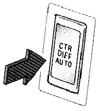
|

|
"C.DIFF AUTO" mode permits control unit to select the locking rate depending on the driving conditions, when auto mode is OFF the center differential remains free. The button is installed at all models with A241H and early models with A540H (since 1994 the button is absent and automatic mode activated permanently).
Standard for everyday driving is the automatic mode, so disabling it is provided only for towing or using the undersized spare wheel.
| Model | Production | Transmission | Differential locking |
| Caldina 190 | 1992-2002 | 4AT A540H+AF2BE | center - electronically controlled hydromechanical clutch |
| Carina 190 | 1992-1996 | 4AT A540H+AF2BE | center - electronically controlled hydromechanical clutch |
| Carina 210 | 1996-08.1998 | 4AT A540H+AF2BE | center - electronically controlled hydromechanical clutch |
| Carina ED 200 | 1993-1998 | 4AT A540H+AF2BE | center - electronically controlled hydromechanical clutch |
| Corolla / Sprinter 90 | 1987-1992 | 4AT A241H | center - hydromechanical clutch |
| Corolla / Sprinter 100 | 1992-2002 | 4AT A241H | center - hydromechanical clutch |
| Corolla / Sprinter 110 | 1995-2000 | 4AT A241H | center - hydromechanical clutch |
| Corolla Spacio 110 | 1997-2002 | 4AT A241H | center - hydromechanical clutch |
| Corona 190 | 1992-1996 | 4AT A540H+AF2BE | center - electronically controlled hydromechanical clutch |
| Corona 210 | 1996-12.1997 | 4AT A540H+AF2BE | center - electronically controlled hydromechanical clutch |
| Corona Exiv 200 | 1993-1998 | 4AT A540H+AF2BE | center - electronically controlled hydromechanical clutch |
| Ipsum 10 | 1996-04.1998 | 4AT A540H+AF2BE | center - electronically controlled hydromechanical clutch |
| RAV4 10 | 1994-2000 | 4AT A540H+AF2BE | center - electronically controlled hydromechanical clutch, rear - Torsen (opt.) |
| Sprinter Carib 95 | 1988-1995 | 4AT A241H | center - hydromechanical clutch |
| Sprinter Carib 110 | 1995-2002 | 4AT A241H | center - hydromechanical clutch |
| Vista / Camry 20 | 1988-1990 | 4AT A540H+AF2BE | center - electronically controlled hydromechanical clutch |
| Vista / Camry 30 | 1990-1994 | 4AT A540H+AF2BE | center - electronically controlled hydromechanical clutch |
| Vista / Camry 40 | 1994-1998 | 4AT A540H+AF2BE | center - electronically controlled hydromechanical clutch |
Full-time all wheel drive. Center differential - symmetrical, bevel gears (front/rear torque distribution 50/50), locking - by viscous coupling.
Torsen type rear LSD was available as option.
| Model | Production | Transmission | Differential locking |
| Alphard 10 | 2002-2008 | 4AT U140F+MF2AV | center - viscous coupling, rear - Torsen (opt.) |
| Caldina 215W GTT | 1997-2002 | 4AT U140F+MF2AV | center - viscous coupling |
| Caldina 246 GT4 | 2002-2007 | 4AT U140F+MF2AV | center - viscous coupling, rear - Torsen (opt.) |
| Harrier 10 | 1997-2003 | 4AT U140F+MF2AV | center - viscous coupling, rear - Torsen (opt.) |
| Harrier ACU35/GSU3# | 2003-2013 | 4AT U140F+MF2AV
5AT U151F+MF2AV | center - viscous coupling, rear - Torsen (opt.) |
| Highlander 20 | 2000-2003 | 4AT U140F+MF2AV | center - viscous coupling, rear - Torsen (opt.) |
| Kluger | 2000-2007 | 4AT U140F+MF2AV | center - viscous coupling, rear - Torsen (opt.) |
| Lexus RX MCU3# | 1998-2003 | 4AT U140F+MF2AV | center - viscous coupling, rear - Torsen (opt.) |
| Lexus RX350 GSU3# | 2006-2008 | 5AT U151F+MF2AV | center - viscous coupling |
| RAV4 20 | 2000-2006 | 4AT U140F+MF2AV | center - viscous coupling, rear - Torsen (opt.) |
Full-time all wheel drive. Center differential - symmetrical, bevel gears (front/rear torque distribution 50/50), free.
The locking emulation is performed using VSC - slipping wheel is braked, thus torque at the other wheel of same axle is increased. Similarly, the torque is redistributed between the front and rear wheels.
| Model | Production | Transmission |
| Harrier MCU35 | 2003-2006 | 4AT U140F' |
| Highlander 20 | 2003-2007 | 4AT U140F' |
| Highlander 40 | 2007-2014 | 5AT U151F |
| Sienna 20 | 2003-2010 | 5AT U151F |
| Lexus RX MCU35 | 2003-2006 | 4AT U140F'+MF2A |
1.2. On-demand all wheel drive
|
Basic front-wheel drive, no center differential, the rear wheels are connected via viscous-friction coupling.
RBC coupling connects the two parts of the intermediate propeller shaft and operates when a significant slip of the front wheels occurs, at other times the car remains front-wheel drive.
For details - "Toyota AWD. V-Flex".
| Model | Production | Transmission |
| bB 30 | 2000-2005 | 4AT U340F |
| Funcargo | 1999-2005 | 4AT U340F |
| Ist 60 | 2002-2007 | 4AT U340F |
| Platz | 1999-2005 | 4AT U340F |
| Porte 10 | 2004-2012 | 4AT U340F |
| Raum 10 | 1997-2003 | 4AT A244F+CF1A |
| Raum 20 | 2003-2011 | 4AT U340F |
| Starlet 80 | 1989-1996 | 4AT A244F+CF1A |
| Starlet 90 | 1996-1999 | 4AT A244F+CF1A |
| Tercel / Corsa / Corolla II 40 | 1990-1994 | 4AT A244F+CF1A |
| Tercel / Corsa / Corolla II 50 | 1994-1999 | 4AT A244F+CF1A |
| Vitz 10 | 1999-2005 | 4AT U340F+MF1A |
| Will Cypha | 2002-2005 | 4AT U340F |
Basic front-wheel drive, no center differential, the rear wheels are connected via viscous coupling.
The viscous coupling connects the two parts of the intermediate propeller shaft and operates when a significant slip of the front wheels occurs, at other times the car remains front-wheel drive.
| Model | Production | Transmission |
| Probox / Succeed 50 | 2002-2014 | 4AT U340F |
| Probox / Succeed 160 | 2014-.. | CVT K310F |
Basic front-wheel drive, no center differential, the rear wheels are connected via viscous coupling.
The coupling filled with silicone fluid, connects the propeller shaft to the input shaft of the rear differential and operates when a significant slip of the front wheels occurs, at other times the car remains front-wheel drive.
For details - "Toyota AWD. V-Flex".
| Model | Production | Transmission |
| Avensis 250 | 2003-2008 | 4AT A248F |
| bB QNC25 | 2006-2016 | 4AT 8RN |
| Belta | 2005-2012 | 4AT U441F |
| Caldina 215G | 1997-2002 | 4AT A241F,A243F+MF1A |
| Caldina 240 | 2002-2007 | 4AT A248F+MF1A |
| Camry / Camry Gracia / Mark II Qualis V20 | 1997-2001 | 4AT A541F |
| Camry V30 | 2001-2006 | 4AT U140F'' |
| Camry V40 | 2006-2011 | 4AT U140F'' |
| Carina 210 | 08.1998-2001 | 4AT A241F,A243F+MF1A |
| Corolla / Fielder / Runx / Allex 120 | 2000-2006 | 4AT U340F,U341F+MF1A |
| Corolla Axio / Fielder 140 | 2006-2012 | CVT K310F, K311F |
| Corolla Spacio 120 | 2001-2007 | 4AT U341F |
| Corona 210 | 12.1997-2001 | 4AT A241F,A243F+MF1A |
| Duet* | 1998-2004 | - |
| Matrix 130 | 2002-2006 | 4AT U341F |
| Opa | 2000-2005 | 4AT U341F+MF1A |
| Passo KGC15* | 2004-2010 | 4AT 8QP |
| Passo KGC35* | 2010-2016 | CVT 2RA |
| Passo M710A* | 2016-.. | CVT 2PL |
| Pixis Epoch LA310A* | 2012-2017 | CVT 6QD |
| Pixis Epoch LA360A* | 2017-.. | CVT 6RA |
| Pixis Joy LA260A* | 2016-2023 | CVT 6QG |
| Pixis Mega LA710A* | 2015-2022 | CVT 1QS |
| Pixis Space L585A* | 2011-2017 | CVT 6QB |
| Premio / Allion 240 | 2001-2007 | 4AT U341F+MF1A |
| Premio / Allion 260 | 2007-2014 | CVT K311F |
| Ractis 100 | 2005-2010 | 4AT U340F |
| Sienta 80 | 2003-2015 | 4AT U340F |
| Tank / Roomy M910A* | 2016-.. | CVT 2QL |
| Vista 50 | 1998-2003 | 4AT U240F+MF1A |
| Vitz 90 | 2005-2010 | 4AT U441F |
| Voltz | 2002-2004 | 4AT U341F |
| Will VS | 2001-2004 | 4AT U341F |
* - Daihatsu models, sold under Toyota brand
Basic front-wheel drive, no center differential, the rear wheels are connected via multi-plate electromechanical coupling.
The coupling connects the propeller shaft to the input shaft of the rear differential. In most cases, the car remains front-wheel drive, but if necessary, the control system automatically maintains the target value of torque transmitted to the rear wheels.
Detailed description - "Toyota AWD. ATC/DTC".
The original name is "Active Torque Control", since 2012 at some models the system receives the designation "Dynamic Torque Control".
| Model | Production | Transmission |
| Alphard / Vellfire 20 | 2008-2015 | 6AT U660F |
| Alphard / Vellfire 30 | 2015-2023 | CVT K115F |
| Alphard / Vellfire 40 | 2023-.. | - |
| Auris 150 | 2007-2012 | CVT K310F,K311F |
| Auris 180 | 2012-2018 | CVT K310F |
| Blade 150 | 2007-2012 | CVT K112F |
| C-HR | 2016-.. | CVT K313F |
| Camry V70 | 2020-.. | 8AT UB80F |
| Corolla Axio 160 | 2012-.. | CVT K310F |
| Corolla Fielder 160 | 2012-.. | CVT K310F |
| Corolla Rumion 150 | 2007-2016 | CVT K311F |
| Corolla Sport 210 | 2018-2022 | CVT K310F |
| Corolla Cross | 2021-.. | CVT K120F |
| Estima 40 | 1999-2006 | 4AT U140F''' |
| Estima 50 | 2006-2019 | 6AT U660F''' |
| Gaia | 1998-2004 | 4AT A243F+MF1A |
| Grand Highlander | 2023-.. | - |
| Harrier 60 | 2013-2020 | CVT K114F |
| Harrier 80 | 2020-.. | CVT K120F |
| Highlander 50 | 2013-2019 | 6AT U660F |
| Highlander 70 (low-grade) | 2019-.. | 8AT UA80F |
| Ipsum 10 | 04.1998-2001 | 4AT A243F+MF1A |
| Ipsum 20 | 2001-2009 | 4AT A243F+MF1A |
| Isis | 2004-2017 | CVT K111F, K311F |
| Ist 110 | 2007-2016 | CVT K310F |
| Lexus NX GZ15 | 2014-2021 | 6AT U661F |
| Lexus NX GZ25 | 2021-.. | 8AT UB80F,UA81F |
| Lexus RX GGL15 | 2008-2015 | 6AT U660F |
| Lexus RX AL20 | 2015-2022 | 6AT U661F, 8AT U881F |
| Lexus RX AL10 | 2022-.. | 8AT UA81F |
| Mark X Zio | 2007-2013 | CVT K112F |
| Matrix 140 | 2008-2013 | 4AT U140F'' |
| Nadia | 1998-2003 | 4AT A243F+MF1A |
| Noah / Voxy 60 | 2001-2007 | CVT K111F, 4AT A248F |
| Noah / Voxy 70 | 2007-2014 | CVT K111F |
| Noah / Voxy / Esquire 80 | 2014-2021 | CVT K114F |
| Noah / Voxy 90 | 2022-.. | CVT K120F |
| Porte / Spade 140 | 2012-2020 | CVT K310F |
| Premio / Allion 260 | 2014-2021 | CVT K311F |
| Ractis 120 | 2010-2016 | CVT K310F |
| Raize A210A* | 2019-.. | CVT N2N |
| RAV4 30 / Vanguard | 2006-2016 | CVT K111F,K112F, 5/6AT U151F, U660F |
| RAV4 40 | 2013-2018 | CVT K111F, 6AT U660F,U760F |
| RAV4 50 (low grade) | 2018-.. | 8AT UB80F, CVT K120F |
| Sienna 30 | 2010-2020 | 6AT U660F |
| Sienta 170 | 2015-2022 | CVT K310F |
| Venza 10 | 2008-2017 | 6AT U660F, U760F |
| Vitz 130 | 2010-2020 | CVT K310F |
| Wildlander | 2020-.. | CVT K120F |
| Wish 10 | 2003-2009 | 4AT U341F |
| Wish 20 | 2009-2017 | CVT K311F |
| Yaris 210 | 2020-.. | CVT K320F |
| Yaris Cross | 2020-.. | CVT K320F |
Basic front-wheel drive, no center and rear differentials, the rear wheels are connected via independent couplings.
In most cases, the car remains front-wheel drive, if necessary the control system automatically adjusts the value of the torque transmitted to each of the rear wheels. In addition, the mechanism designed for disconnection of powertrain in the transfer case and in the rear axle, so that the propeller shaft and gears are not rotated in 2WD mode.
The official name - "Dynamic Torque Vectoring AWD", the drive type is presented in 2018.
Detailed description - "Toyota AWD. DTV"
| Model | Production | Transmission |
| Highlander 70 (hi grade) | 2019-.. | 8AT UA80F |
| RAV4 50 (hi grade) | 2018-.. | 8AT UB80F, CVT K120F |
| Wildlander (hi grade) | 2020-.. | CVT K120F |
Basic front-wheel drive, no center differential, the rear axle is connected mechanically.
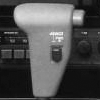 The very first and dead-end branch of Toyota front-wheel drive development (with a longitudinal engine over the transmission) gave rise to its own 4WD type. Rear drive control - by a button on the selector, the actuator - vacuum servo. The very first and dead-end branch of Toyota front-wheel drive development (with a longitudinal engine over the transmission) gave rise to its own 4WD type. Rear drive control - by a button on the selector, the actuator - vacuum servo.
| Model | Production | Transmission |
| Sprinter Carib AL25 | 1983-1988 | 3AT |
| Tercel AL25 | 1984-1989 | 3AT |
| Corsa AL25 | 1984-1989 | 3AT |
1.3. Electrical all wheel drive
|
Basic front-wheel drive, without a mechanical link between the axles, the rear wheels are driven by a separate electric motor.
Two types of rear power modules are used - the classic three-shaft (several power and torque variants) and a compact two-shaft with a low-power electric motor (HV4WD).
Some details - "Toyota AWD. E-Four"
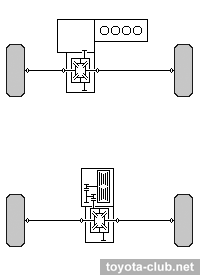
|
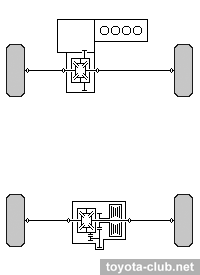
|
| Model | Production | Rear motor (kW/Nm) |
| Alphard ATH10 | 2003-2008 | 1FM (18/108) |
| Alphard/Vellfire ATH20 | 2008-2015 | 2FM (50/130) |
| Alphard/Vellfire AYH30 | 2015-2023 | 2FM (50/139) |
| Alphard/Vellfire AAHH45 | 2023-.. | 4NM (40/121) |
| Aqua MXPK15.16 | 2021-.. | 1MM (5.3/55) |
| bZ4X YEAM15 | 2022-.. | 1YM (80/169) |
| C-HR MAXH25 | 2023-.. | 1WM (30/84) |
| Camry AXVH75 | 2019-.. | 1MM (5.3/55) |
| Century GRG75 | 2023-.. | 1YM (80/169) |
| Corolla ZWE214 | 2019-2022 | 1MM (5.3/55) |
| Corolla ZWE215 | 2022-.. | 1WM (30/84) |
| Corolla Cross ZVG15 | 2022-.. | 1MM (5.3/55) |
| Corolla Cross ZVG16 | 2023-.. | 1WM (30/84) |
| Corolla Touring ZWE214W | 2019-2022 | 1MM (5.3/55) |
| Corolla Touring ZWE215 | 2022-.. | 1WM (30/84) |
| Crown Crossover TZSH35 | 2022-.. | 1YM (59/169) |
| Crown Crossover AZSH35 | 2022-.. | 4NM (40/121) |
| Crown Sport AZSH3#W | 2023-.. | 4NM (40/121) |
| Estima AHR10 | 2001-2006 | 1FM (18/108) |
| Estima AHR20 | 2006-2019 | 2FM (50/130) |
| Harrier MHU38 | 2005-2012 | 2FM (50/130) |
| Harrier AVU65 | 2013-2020 | 2FM (50/139) |
| Harrier AXUH85 | 2020-.. | 4NM (40/121) |
| Highlander MHU28 | 2005-2007 | 2FM (50/130) |
| Highlander MHU48 | 2007-2010 | 2FM (50/130) |
| Highlander GVU48 | 2010-2014 | 2FM (50/130) |
| Highlander GVU58 | 2014-2019 | 2FM (50/139) |
| Highlander AXUH78 | 2019-.. | 4NM (40/120) |
| Kluger MHU28 | 2005-2007 | 2FM (50/130) |
| Lexus LBX MAYH15 | 2023-.. | 1MM (5/52) |
| Lexus LM350h AAWH15 | 2023-.. | 4NM (40/121) |
| Lexus LM500h TAWH15 | 2023-.. | 1YM (76/169) |
| Lexus NX300h AYZ15 | 2014-2021 | 2FM (50/139) |
| Lexus NX350h AAZH2# | 2021-.. | 4NM (40/121) |
| Lexus NX450h AAZH2# | 2021-.. | 4NM (40/121) |
| Lexus RX350h AALH16 | 2022-.. | 4NM (40/121) |
| Lexus RX400h MHU38 | 2005-2008 | 2FM (50/130) |
| Lexus RX450h GYL15 | 2009-2015 | 2FM (50/130) |
| Lexus RX450h GYL25 | 2015-2022 | 2FM (50/139) |
| Lexus RX450h+ AALH16 | 2022-.. | 4NM (40/121) |
| Lexus RX500h TALH17 | 2022-.. | 1YM (76/169) |
| Lexus RZ450e XEBM15 | 2023-.. | 1YM (80/169) |
| Lexus TX500h+ | 2023-.. | 1YM (76/169) |
| Lexus TX550h+ | 2023-.. | 1YM (80/169) |
| Lexus UX250h MZAH15 | 2018-2023. | 1MM (5/55) |
| Lexus UX300h MZAH16 | 2023-.. | 1WM (30/84) |
| Mitsuoka Buddy | 2020-.. | 4NM (40/121) |
| Noah/Voxy ZWR95W | 2022-.. | 1WM (30/84) |
| Prius ZVW55 | 2015-2022 | 1MM (5.3/55) |
| Prius MXWH65 | 2023-.. | 1WM (30/84) |
| Prius ZVW65 | 2023-.. | 1WM (30/84) |
| RAV4 AVA44 | 2015-2018 | 2FM (50/139) |
| RAV4 AXAH54 | 2018-.. | 4NM (40/120) |
| RAV4 PHV AXAP54 | 2020-.. | 4NM (40/121) |
| Sienna AXLH45 | 2020-.. | 4NM (40/121) |
| Sienta MXPL15G | 2022-.. | 1MM (2.2/44) |
| Subaru Solterra | 2022-.. | 1YM (80/169) |
| Suzuki Across | 2020-.. | 4NM (40/121) |
| Suzuki Landy | 2022-.. | 1WM (30/84) |
| Venza AXUH85 | 2020-.. | 4NM (40/121) |
| Wildlander AXAH54 | 2020-.. | 4NM (40/120) |
| Yaris MXPH15 | 2020-.. | 1MM (5.3/52) |
| Yaris Cross MXPJ15 | 2020-.. | 1MM (5.3/52) |
Abbreviations: TM - transmission (gearbox, CVT), TR - transfer, FD - front differential, RD - rear differential, CD - center differential, CDC - hydraulic clutch, VC - viscous coupling, EC - electromechanic coupling.
Development, efficiency, reliability
|
The history of Toyota 4WD for the initially FWD cars started in 1988.
STD I type, which appeared in the most boom years of the Japanese automotive industry, remains the most perfect, reliable and efficient among all variations of the all-wheel drive of Toyota road cars. This "Full-Time 4WD" really was a permanent, "full" and, importantly, built on the basis of problem-free and steady automatic gearboxes. The only fundamental drawback (by modern standards) is the absence of any axle differential lockings, which makes the cars sensitive to conditional diagonal. Alas, the production of the last STD I models was finished in 2002.
For the B-class models Toyota used part-time 4WD (Flex and V-Flex I) from the late 1980s until the 2010s. Currently, this type is applied to the only utilitarian model of Toyota.
The protracted crisis of the 1990s made a total economy as a new trend - economy on materials, useful options, and, of course, construction perfections. The break of Toyota 4WD came after 1997 - with the start and massive implementation of V-Flex II, one of the most advanced systems changed to the most primitive. Its drawbacks are well known:
- delayed "operation" of viscous coupling,
- limited locking ability,
- potential danger when active driving,
- limited coupling lifetime.
Of course, even such a dubious 4WD remained preferable to a mono-drive, but the problem is that experienced owners had something to compare with. Since 2015, the V-Flex II is no longer used for the models developed by Toyota itself, and remains an attribute of only Daihatsu rebaged models.
The most common type of all-wheel drive in the world - with the electromechanical coupling - was introduced for Toyota in 1998 (ATC). Initially - for minivans, but gradually it came to the lower classes, replacing V-Flex, and to the SUV class, eliminating the remnants of full-time.. Drawbacks of this type:
- limited locking ability,
- limited operation time under load,
- wear of the coupling bearings ( for details, "ATC coupling repair").
In general, the effectiveness of ATC does not reach a full-time AWD, but significantly exceeds V-Flex.
It is worth noting one more thing - the end of the 1990s was marked by the appearance of new Toyota / Aisin transmissions (the latest versions of A24# serie, U-series), the service life of which, compared to its predecessors, drastically decreased, which was especially noticeable for more loaded AWD vehicles. As a result, 4WD transmissions became not only less efficient, but at the same time less reliable.
For the class of SUVs / crossovers just started at that time, Toyota retained the full-time in the simplest version (STD II), which actually borrowed from the previous models with mechanical gearboxes (except that installing five satellites instead of four in the center differential). The expected low efficiency of viscous couplings in comparison with hydromechanical ones affected the performance in this case too.
By the middle of the 2000s, the development of technology allowed to completely abandon viscous coupling, leaving all three differentials free (VSC+) - now the lockings were emulated using the brake system. This type remained in production not too long and soon all the crossovers received ATC 4WD.
In general, the implementation of vehicles stability systems (Japanese brands - since the second half of 2000s) and the appearance of difflock emulation by brakes, a new stage of 4WD development began in the world. Some manufacturer's selectable 4WD and ESP gives a better effect than even some versions of the full-time with an excessively "soft" center locking or its emulation. But not in the case of Toyota - comparing the actual behavior of modern SUVs of different brands it is necessary to recognize - Toyota's settings of the selectable 4WD and difflock emulations are extremely unsuccessful. Some improvements were outlined only with the release of new models at the very end of the 2010s.
Not in the best way the rejection of AT in favor of CVT reflected on the performance of the all-wheel drive, which continues since the mid 2000s (mono-drive versions received CVT even earlier). This is not so important for light cars, but for minivans and, especially, crossovers, CVT becomes the narrowest, most vulnerable and expensive part of the power transmission circuit between the engine and wheels.
Another type of conditionally all-wheel drive known since 2001, has formed by numerous hybrid models (E-4WD). With the external temptation of the idea, the nice values and the diagrams of the rear motor torque, in reality the traction capabilities did not meet expectations - E-4WD efficiency does not even reach ATC of similar non-hybrid models.
Own "torque vectoring" type (DTV) Toyota introduced only in 2018, eight years later than Nissan, almost fifteen later than Honda and two decades after the MMC. Potius sero quam nunquam.
Toyota all-wheel drive. Review
·
ATC/DTC ·
V-Flex ·
DTV ·
i-Four ·
Torsen ·
E-Four ·
·
C.Diff Auto
A241H /
A540H ·
C.Diff Lock ·
C.Diff Visc ·
FT-Visc ·
|
|
|
 The very first and dead-end branch of Toyota front-wheel drive development (with a longitudinal engine over the transmission) gave rise to its own 4WD type. Rear drive control - by a button on the selector, the actuator - vacuum servo.
The very first and dead-end branch of Toyota front-wheel drive development (with a longitudinal engine over the transmission) gave rise to its own 4WD type. Rear drive control - by a button on the selector, the actuator - vacuum servo.
